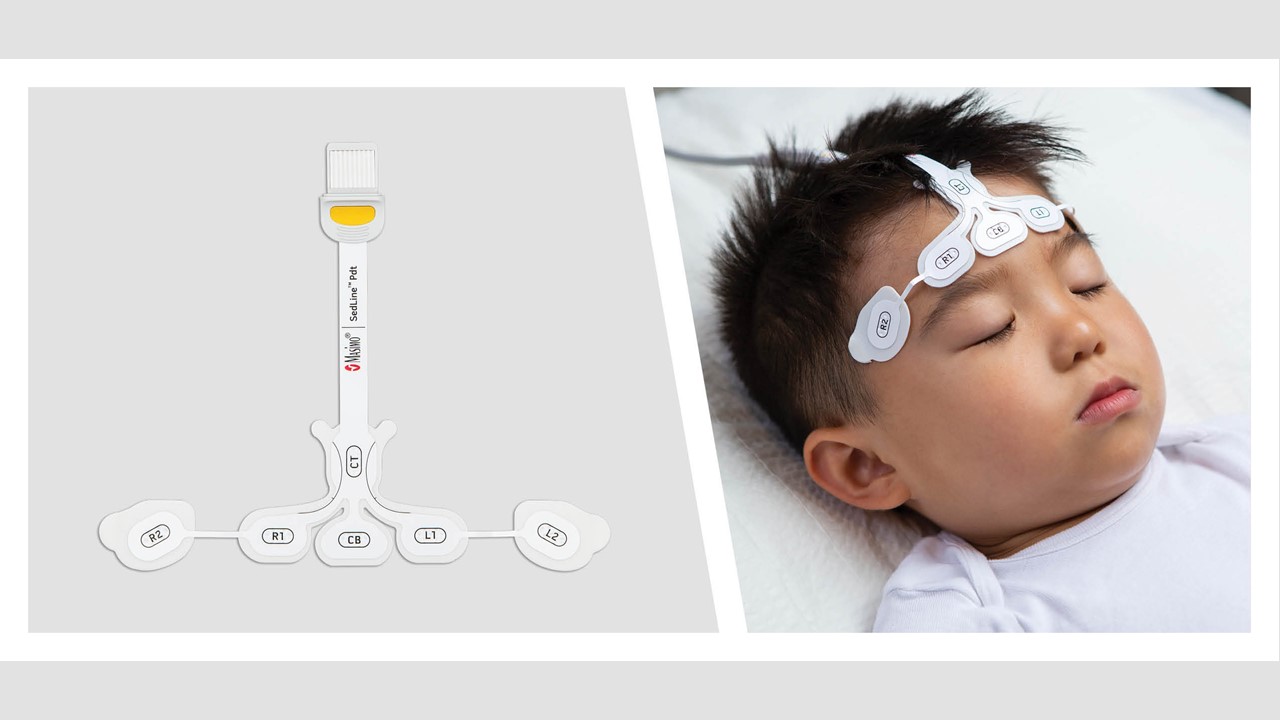Anesthesiologists Used Less Sevoflurane to Maintain Appropriate Anesthesia in Children Monitored with Masimo SedLine
Masimo recently announced the findings of a randomized, controlled trial published in the Journal of Clinical Anesthesia in which Dr. Melody H.Y. Long and colleagues from the KK Women’s and Children’s Hospital in Singapore evaluated the ability of electroencephalogram (EEG)-guided anesthesia, using Masimo SedLine® brain function monitoring, to reduce the amount of the drug sevoflurane needed to maintain anesthesia in pediatric patients undergoing minor surgery.1 They found that use of SedLine to guide anesthesia reduced sevoflurane requirements and led to a reduced incidence of burst suppression, which has previously been reported to be associated with postoperative delirium.2-7

Noting the unique nature of pediatric brains, which are still developing, the importance that standard anesthesia practice places on minimizing the dosage of drugs needed to maintain anesthesia, and the lack of research into the use of new technology like real-time EEG spectrogram monitoring in children, the researchers devised a study that would investigate what impact such technology might have. They enrolled 195 children, aged 1 to 6 years, who were scheduled for minor surgery involving general anesthesia induced and maintained using sevoflurane. The children were randomized into either a Masimo SedLine EEG-guided group (n=100) or a standard care group (n=95). In the SedLine EEG group, anesthesiologists used SedLine to help guide administration of sevoflurane, with the goals of maintaining continuous slow/delta oscillations on the raw EEG and spectrogram, avoiding burst suppression, and maintaining a Patient State Index, or PSi – a propriety, processed EEG parameter developed by Masimo – between 25 and 50. In the standard care group, clinicians were blinded to the EEG data.
As their primary outcome, the researchers looked at the average end-tidal concentration of sevoflurane used during induction and maintenance of anesthesia. They found that in the EEG group, the concentration was lower both during induction (4.80% compared to 5.67% in the control group, p=0.003) and maintenance (2.23% vs. 2.38%, p=0.005). As one of their secondary outcomes, the researchers compared the incidence and duration of intraoperative burst suppression, and found that the EEG group had a lower incidence of burst suppression (3.1% vs. 10.9% in the control group, p=0.0440).
The authors concluded, “This is one of the first randomized control trials in the pediatric population showing that EEG-guided anesthesia care utilizing the spectrogram is feasible, and leads to a modest decrease in intraoperative sevoflurane dosage for induction and maintenance in young children aged 1 to 6 years. EEG guidance allows easy visualization of anesthesia-induced changes on the brain in real time, making it possible to determine which individuals require more (or less) anesthetic to maintain unconsciousness and titrate doses accordingly. This may be particularly important in children between 1 and 2 years old, who appear to require a higher concentration of sevoflurane during surgery, as well as in patients at risk of neurological injury. Our findings highlight the importance of EEG monitoring in complementing the current ASA standard monitors, to provide personalized anesthesia care.”
William C. Wilson, MD, MA, CMO and SVP of Clinical Research and Medical Affairs at Masimo, commented, “We believe the significant reduction in burst suppression noted in the EEG group – less than one-third the amount in the control group – is an important finding. In future studies with larger sample pools, this could demonstrate more profound outcome benefits.”
In the U.S., SedLine is currently indicated for pediatric use without the PSi parameter.
About Masimo
Masimo is a global medical technology company that develops and produces a wide array of industry-leading monitoring technologies, including innovative measurements, sensors, patient monitors, and automation and connectivity solutions. Our mission is to improve patient outcomes and reduce the cost of care. Additional information about Masimo and its products may be found at www.masimo.com. Published clinical studies on Masimo products can be found at www.masimo.com/evidence/featured-studies/feature/.
ORi and RPVi have not received FDA 510(k) clearance and are not available for sale in the United States. The use of the trademark Patient SafetyNet is under license from University HealthSystem Consortium.
References
- Long MHY, Lim EHL, Balanza GA, Allen JC, Purdon PL, and Bong CL. Sevoflurane requirements during electroencephalogram (EEG)-guided vs. standard anesthesia care in children: A randomized controlled trial. J Clin Anesth. 27 Jun 2022. DOI: https://doi.org/10.1016/j.jclinane.2022.110913,
- Tang CJ, Jin Z, Sands LP, Pleasants D, Tabatabai S, Hong Y, Leung JM. ADAPT-2: A Randomized Clinical Trial to Reduce Intraoperative EEG Suppression in Older Surgical Patients Undergoing Major Noncardiac Surgery. Anesth Analg 2020; 131(4):1228-1236.
- Radtke FM, Franck M, Lendner J, Krüger S, Wernecke KD, Spies CD. Monitoring depth of anaesthesia in a randomized trial decreases the rate of postoperative delirium but not postoperative cognitive dysfunction. Br J Anaesthesia. (2013) 110:98–105. doi: 10.1093/bja/aet055.
- MacKenzie KK, Britt-Spells AM, Sands LP, Leung JM. Processed electroencephalogram monitoring and postoperative delirium: a systematic review and meta-analysis. Anesthesiology. (2018)129:417–27. doi: 10.1097/ALN.0000000000002323.
- Sieber FE, Zakriya KJ, Gottschalk A, Blute MR, Lee HB, Rosenberg PB, et al. Sedation depth during spinal anesthesia and the development of postoperative delirium in elderly patients undergoing hip fracture repair. Mayo Clin Proc. (2010) 85:18–26. doi: 10.4065/mcp.2009.0469.
- Whitlock EL, Torres BA, Lin N, Helsten DL, Nadelson MR, Mashour GA, et al. Postoperative delirium in a substudy of cardiothoracic surgical patients in the BAG-RECALL clinical trial. Anesth Analg. (2014) 118:809–17. doi: 10.1213/ANE.000000000000002.
- Xu N, Li L, Wang T, Jiao L, Hua Y, Yao D, Wu J, Ma Y, Tian T, Sun X. Processed Multiparameter Electroencephalogram-Guided General Anesthesia Management Can Reduce Postoperative Delirium Following Carotid Endarterectomy: A Randomized Control Trial. Front Neurol. 12 July 2021. 12:666814. doi: 10.3389/fneur.2021.666814.
- Published clinical studies on pulse oximetry and the benefits of Masimo SET® can be found on our website at http://www.masimo.com. Comparative studies include independent and objective studies which are comprised of abstracts presented at scientific meetings and peer-reviewed journal articles.
- Castillo A et al. Prevention of Retinopathy of Prematurity in Preterm Infants through Changes in Clinical Practice and SpO2 Technology. Acta Paediatr. 2011 Feb;100(2):188-92.
- de-Wahl Granelli A et al. Impact of pulse oximetry screening on the detection of duct dependent congenital heart disease: a Swedish prospective screening study in 39,821 newborns. BMJ. 2009;Jan 8;338.
- Taenzer A et al. Impact of pulse oximetry surveillance on rescue events and intensive care unit transfers: a before-and-after concurrence study. Anesthesiology. 2010:112(2):282-287.
- Taenzer A et al. Postoperative Monitoring – The Dartmouth Experience. Anesthesia Patient Safety Foundation Newsletter. Spring-Summer 2012.
- McGrath S et al. Surveillance Monitoring Management for General Care Units: Strategy, Design, and Implementation. The Joint Commission Journal on Quality and Patient Safety. 2016 Jul;42(7):293-302.
- McGrath S et al. Inpatient Respiratory Arrest Associated With Sedative and Analgesic Medications: Impact of Continuous Monitoring on Patient Mortality and Severe Morbidity. J Patient Saf. 2020 14 Mar. DOI: 10.1097/PTS.0000000000000696.
- Estimate: Masimo data on file.
- http://health.usnews.com/health-care/best-hospitals/articles/best-hospitals-honor-roll-and-overview.












